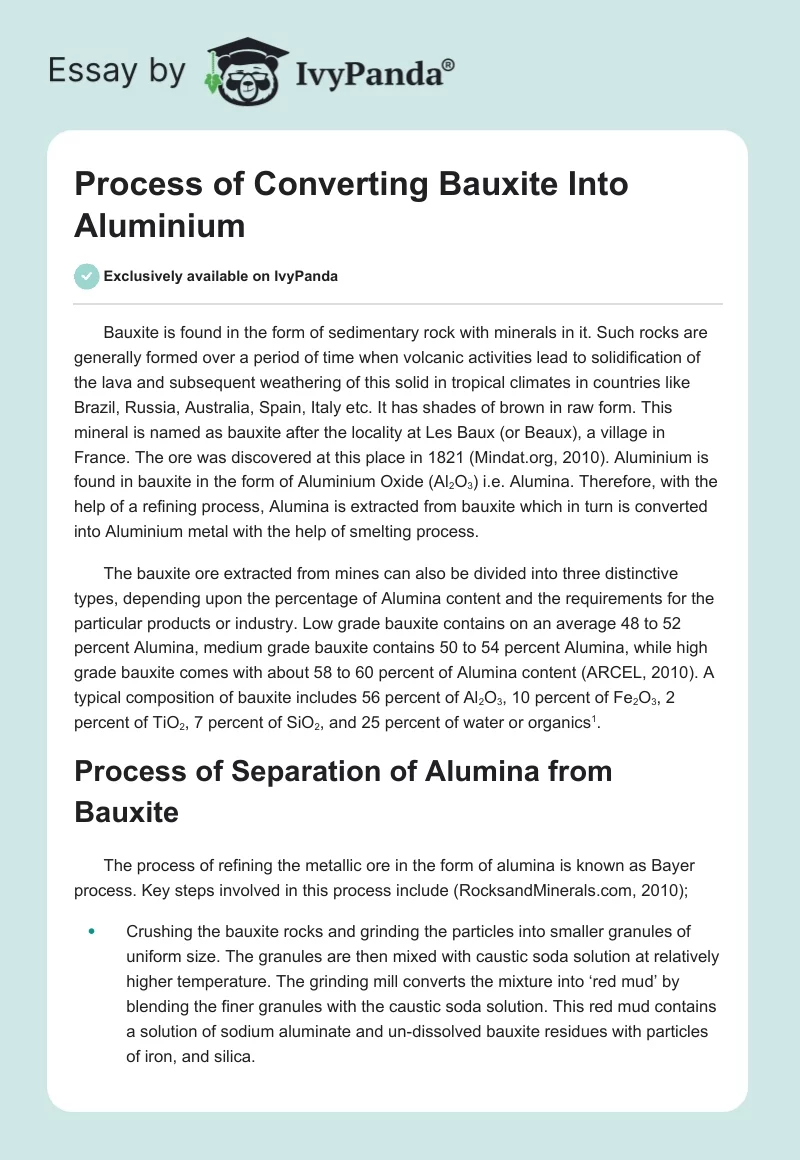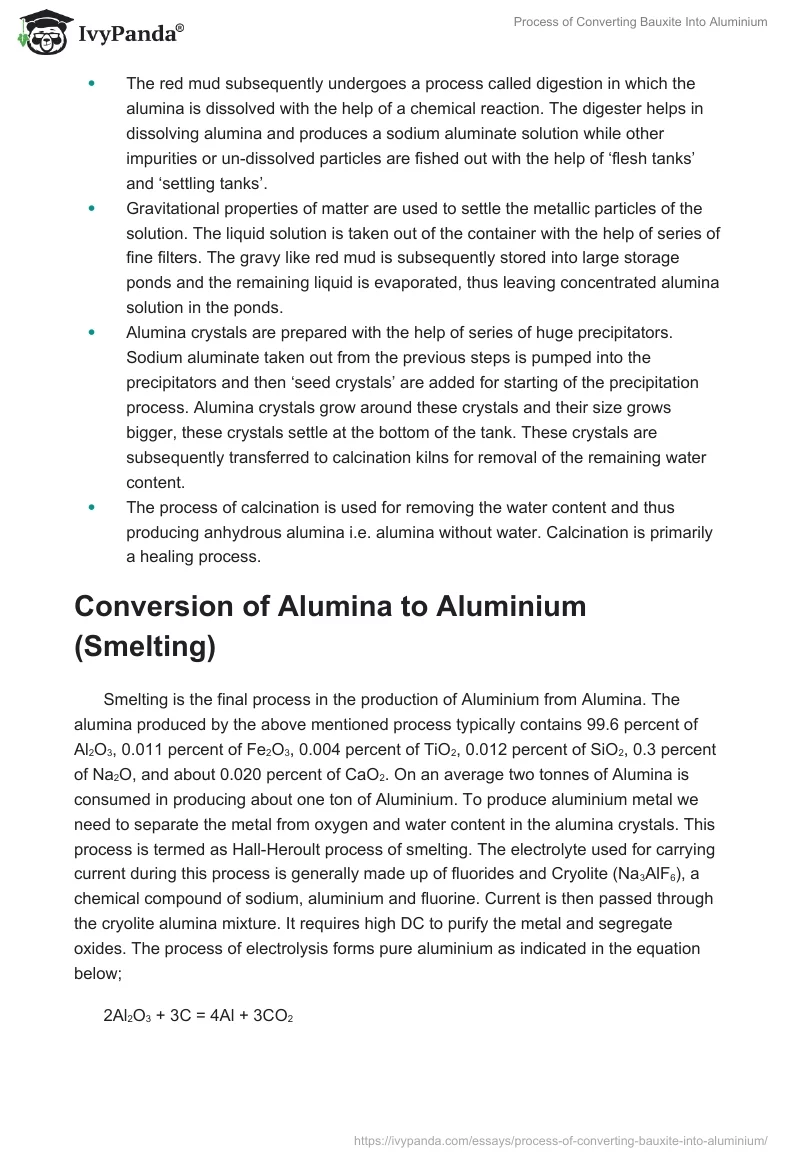Bauxite is found in the form of sedimentary rock with minerals in it. Such rocks are generally formed over a period of time when volcanic activities lead to solidification of the lava and subsequent weathering of this solid in tropical climates in countries like Brazil, Russia, Australia, Spain, Italy etc. It has shades of brown in raw form. This mineral is named as bauxite after the locality at Les Baux (or Beaux), a village in France. The ore was discovered at this place in 1821 (Mindat.org, 2010). Aluminium is found in bauxite in the form of Aluminium Oxide (Al2O3) i.e. Alumina. Therefore, with the help of a refining process, Alumina is extracted from bauxite which in turn is converted into Aluminium metal with the help of smelting process.
The bauxite ore extracted from mines can also be divided into three distinctive types, depending upon the percentage of Alumina content and the requirements for the particular products or industry. Low grade bauxite contains on an average 48 to 52 percent Alumina, medium grade bauxite contains 50 to 54 percent Alumina, while high grade bauxite comes with about 58 to 60 percent of Alumina content (ARCEL, 2010). A typical composition of bauxite includes 56 percent of Al2O3, 10 percent of Fe2O3, 2 percent of TiO2, 7 percent of SiO2, and 25 percent of water or organics.
Process of Separation of Alumina from Bauxite
The process of refining the metallic ore in the form of alumina is known as Bayer process. Key steps involved in this process include (RocksandMinerals.com, 2010);
- Crushing the bauxite rocks and grinding the particles into smaller granules of uniform size. The granules are then mixed with caustic soda solution at relatively higher temperature. The grinding mill converts the mixture into ‘red mud’ by blending the finer granules with the caustic soda solution. This red mud contains a solution of sodium aluminate and un-dissolved bauxite residues with particles of iron, and silica.
- The red mud subsequently undergoes a process called digestion in which the alumina is dissolved with the help of a chemical reaction. The digester helps in dissolving alumina and produces a sodium aluminate solution while other impurities or un-dissolved particles are fished out with the help of ‘flesh tanks’ and ‘settling tanks’.
- Gravitational properties of matter are used to settle the metallic particles of the solution. The liquid solution is taken out of the container with the help of series of fine filters. The gravy like red mud is subsequently stored into large storage ponds and the remaining liquid is evaporated, thus leaving concentrated alumina solution in the ponds.
- Alumina crystals are prepared with the help of series of huge precipitators. Sodium aluminate taken out from the previous steps is pumped into the precipitators and then ‘seed crystals’ are added for starting of the precipitation process. Alumina crystals grow around these crystals and their size grows bigger, these crystals settle at the bottom of the tank. These crystals are subsequently transferred to calcination kilns for removal of the remaining water content.
- The process of calcination is used for removing the water content and thus producing anhydrous alumina i.e. alumina without water. Calcination is primarily a healing process.
Conversion of Alumina to Aluminium (Smelting)
Smelting is the final process in the production of Aluminium from Alumina. The alumina produced by the above mentioned process typically contains 99.6 percent of Al2O3, 0.011 percent of Fe2O3, 0.004 percent of TiO2, 0.012 percent of SiO2, 0.3 percent of Na2O, and about 0.020 percent of CaO2. On an average two tonnes of Alumina is consumed in producing about one ton of Aluminium. To produce aluminium metal we need to separate the metal from oxygen and water content in the alumina crystals. This process is termed as Hall-Heroult process of smelting. The electrolyte used for carrying current during this process is generally made up of fluorides and Cryolite (Na3AlF6), a chemical compound of sodium, aluminium and fluorine. Current is then passed through the cryolite alumina mixture. It requires high DC to purify the metal and segregate oxides. The process of electrolysis forms pure aluminium as indicated in the equation below;
2Al2O3 + 3C = 4Al + 3CO2
This indicates that as a result of smelting the chemical reaction produces aluminium and carbon dioxide. The molten aluminium settles down at the bottom of the pot, which is then is periodically siphoned off into crucibles. The metal can thus be forged, turned into different types of alloys or used to make different types of appliances. On the other hand the carbon dioxide gas escapes into the environment.
Environmental Issues
Production of aluminium often results in degrading the environment, thus raising concerns about the effectiveness and efficacy of such steps in the long run. Emission of harmful gases in the environment and harmful liquid into the water tables have forced the metal industry to devise ways and means for reducing such pollutants. A study carried out by the Australian aluminium industry has pointed out the continuous rise of harmful emissions due to increase in the production levels.
The tailing or red mud is a cause of pollution in the soil around the aluminium manufacturing unit. Emission of gases, smoke and fluorides from reduction cells is another cause of worry for the environment. To take care of the fluoride problem prebaked technology is used in modern aluminium plants. This allows the pots to be efficiently covered thus reducing the emission of fluorides and allowing the recovery of alumina and fluorides. Two key approaches for reduction of fluoride emission are;
- Non- recoverable wet scrubbing.
- Absorption of the emissions and then recycling them.
Water quality is also affected as a result of aluminium production. Runoff treatment is one way of decontaminating the local water. The water is treated for fluorides and suspended solids before discharge.
References
ARCEL Minerals (2010). ‘Arcel Calcined Bauxite’. Web.
Mindat.org (2010). Bauxite. Web.
RocksandMinerals.com (2010). How Aluminium is Produced? Web.


